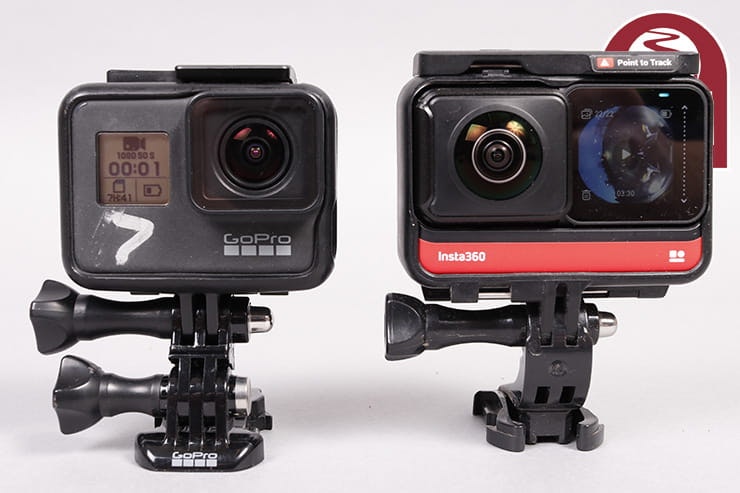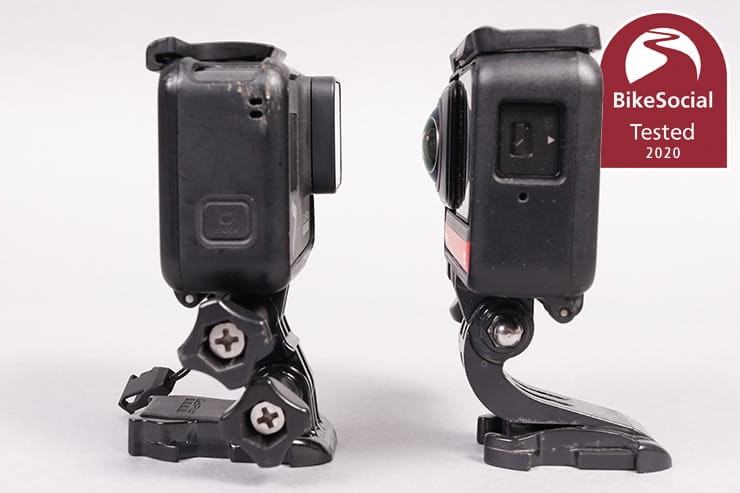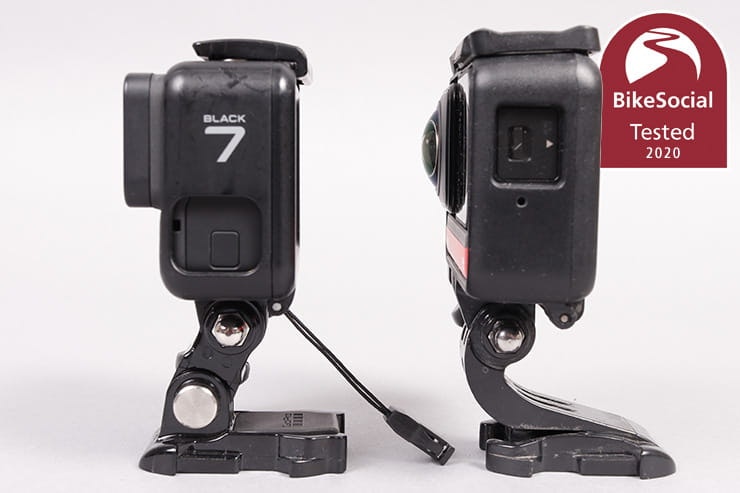Insta360 One R review | Best motorcycle action camera 2020?
By John Milbank
Consumer Editor of Bennetts BikeSocial
16.07.2020
This review aims to show the difference between a standard single-lens action camera and the Insta360 One R
Date reviewed: March 2020 (updated June 2020) | Tested by: John Milbank | Price: £439.99 | store.insta360.com
The Insta360 One R, with its modular design that allows users to swap between a VR-capable 360-degree twin camera, a 4K attachment, and a one-inch sensor, has the potential to be ideal for motorcyclists looking to easily capture great footage while out on a ride.
Being able to reframe your video quickly and easily on your smartphone or computer after the event makes it incredibly versatile but there are limitations, and this review aims to explain whether you should consider upgrading from a ‘standard’ action camera – like a GoPro – to this when filming your biking life…
Easy to get incredible footage
Modular design means damaged parts can be replaced
Three module options make it good value
Lenses on any 360° camera are vulnerable
No one-touch recording (yet)
Gap between clips over 30 minutes long
Impressive angles are easily achieved using the Insta360 One R on the end of the invisible selfie stick
Ease of use
The biggest advantage that a 360 camera like this Insta360 One R has over a ‘traditional’ unit – like the new GoPro Hero8 or my GoPro Hero7 – is that you can reframe your footage after you’ve shot it. Simply put, a 360 camera has two lenses, each shooting a 180° field of view; the camera stitches these together to create a scene that includes, well, everything.
Because the lenses are on either side of the camera’s body, anything within about half a meter or so will be lost if it goes between those two faces.
This hidden stitching can be used to your advantage – mount the camera on the £14.90 invisible selfie stick and your shots will appear to have come from a drone; the support simply disappears. It does mean that when you fit the device to your bike’s fairing, there will be areas that you can’t see to the sides and below. But think about the view you’re likely to use when the shots are edited, and these areas can be avoided – have one of the lenses facing the area that you’re most likely to focus on in your movie and position the joins where items of interest will be further away.
For now, unlike the GoPro 7, you can't simply press the record button to boot the camera up and start recording – you can touch the record button to turn turn it on, but you then still need to press it again to start filming. Before the update, start-up took a total of 14 seconds, but Insta360 has now drastically improved this – you can now be recording within seven seconds of hitting the power button. You will still need to hold the power button again to shut it down, but this is still a significant improvement.
There is also a GPS remote control available, which should make operating the camera easier on the go, and to be honest I can forgive the Insta360 One R a lot of its foibles thanks to the angles I can achieve, and the fact that I can get footage from the side of the road of myself riding, reframing later to give the impression that there was someone panning the camera.
Mounting the camera off the side of the bike can give some exciting shots, but take care when riding
Insta360 One R interface
The small screen on the Insta360 One R shows everything you need, but it’s a little more fiddly to use than the larger standard GoPro display. I also find navigating some of the menus can see them darting about a bit, but this is likely something that will be improved with firmware updates.
If you’re using the 360 module, you can of course hold the camera either way around, but it’s great that with the 4K unit fitted, you can mount the screen facing the front or the back, so you can easily vlog in front of the camera, or set up specific angles from behind.
The twin pack comes with the 360 and the 4K cameras, which plug into the screen
Insta360 One R mounting options
I’ve got the Twin edition of the Insta360 One R, which comes with the twin-camera 360 module, the 4K single camera and of course the screen and battery parts. There’s also a cage to hold the camera – which has a GoPro-compatible bracket attached – and a ¼ inch adaptor to screw onto a tripod (or the selfie stick), but with no sticky mounts, there’s no way to fit it to your bike or helmet out of the box.
Fortunately, Go-Pro compatible mounts are readily available (I have a box-full I’ve collected over the years), and Insta360 has released a motorcycle bundle of clamps, as well as a complete camera package.
The screen is small but functional
Build quality
Overall the Insta360 One R is a solid piece of kit made of what appears to be good quality plastic. The modular build sees complex connectors between each of the three parts that make up the camera, but they have rubber sealing rings. You’ll obviously have to take care of the seals, but having ridden for an hour in driving rain at motorway speeds I can honestly say that water-ingress isn’t an issue, at least on a new / well maintained camera.
When the camera’s separated after use in the wet, moisture can be found trapped between the modules so give these a wipe off before reassembly to ensure none can get into the connectors.
The camera can suffer some serious blasting with water without any negative effects
Because of the extra lens (and the modular build to a certain extent), the Insta360 One R is heavier than a standard action camera but it’s really not proven a problem for me, and with just 3-4g in it when using the 4K module on the Insta360, the GoPro has no major advantage.
I’ve seen mention of fogging issues with the Insta360 One R’s dual lenses, but having taken it from a warm office, straight out into the cold and rain – then filmed until the battery went flat – there certainly doesn’t seem to be any kind of a problem to me.
My only criticism of the Insta360’s build has been the little door that covers the USB-C charging port and the MicroSD card slot; this can pull off a little easily, being tethered only with a plastic line, but it’s easily poked back into place. Just be careful not to lose it.
Of course, as with any camera like this, the 360° lenses are exposed and vulnerable. There are protectors available but I haven’t tried them, and from what I’ve seen they don’t appear to be completely invisible. A silicone cover is supplied with the camera, which does a great job of protecting the glass while it’s in your bag, but on the bike you do need to be aware of the risk of a stone impact. And whatever you do, don’t drop it!
I wanted to push the camera to see what I could get away with, so ended up riding with it brushing through long grass and unfortunately some twigs. The anti-reflective coating on the outside of the glass is clearly scratched, but I haven’t noticed any issues when filming. I’d imagine that if direct sunlight catches it correctly there could be artefacts, but I haven’t noticed anything.
Don’t be careless, but if something does go wrong, at least the lens module can be replaced on its own; the new GoPro Hero8 doesn’t have a replaceable lens cover any more (my old GoPro Hero7 does), so if you damage that it’s had it. Insta360 customer support can repair minor scratches, or if the absolute worst happens, a new 360° module costs just £179.99, which makes the modular design even more attractive.
A silicone cover keeps the lenses protected when not in use
Video quality
The main reason to go for the Insta360 One R is of course the 360° footage, and certainly when shooting for 1080p content, even when zooming in the Insta puts out some great footage; you can see in the video the results I’ve been achieving and compare them to my GoPro Hero7. Keep in mind that none of the Insta360 or GoPro footage has been colour corrected or tweaked at all. The only footage I did grade is from the Hero5 that I used as a second camera while in the garage.
The 360 module is a 5.7K unit, which sounds very impressive but remember that as soon as you reframe it you’ll be cropping a lot of that out; at the longest virtual focal lengths the footage is still fine for a 1920x1080 frame, and remember that most videos are now watched on a phone. Still, even on a large-screen HD-TV this looks great, and don’t be too obsessed with shooting 4K; even the BBC World Service still only shoots for 1080p.
The Insta360 One R allows me to film myself riding, then reframe as if the camera’s being panned
If you edit within the smartphone app, colours appear a little more saturated than those from the desktop app, but the blacks are also more crushed. Only when you see them side-by-side though will you really notice it.
You can shoot in slow-motion using the 360° module, but the resolution drops to 3K to get 100fps – this becomes clearly noticeable, and when you increase the virtual focal length, the footage is extremely pixelated. Ultimately, if you want to shoot at high frame rates, you’re best carefully framing your shot while using a standard single-lens camera; as the twin edition of the Insta360 One R only cost £20 more than the 360 alone, it’s worth getting it for that 4K module, which goes up to 60fps in 4K, 100fps in 2.7K and 200fps in 1080p.
Video quality from the 4K unit is very good, though while the FlowState stabilisation is great, it’s not quite as good as the recent GoPros – I mounted both to the tank of a Royal Enfield Interceptor using exactly the same brackets, and the GoPro did have the edge – you can see the comparison in my video.
Mounting the camera on the side of my Royal Enfield Interceptor allowed me to test the 4K module footage and audio quality
Insta 360 audio quality
Before the firmware update to V1.1.16 I was critical of the Insta360 One R's audio performance, but it has been massively improved. Wind noise is handled well - at speed and speech is much improved. I'll be recording an update video shortly, but for now please watch the video below with the fact that it was recorded with the old firmware in mind.
The battery clips onto the bottom of the lens and screen modules
Insta360 battery life
Keeping in mind the amount of processing required to film 360° footage, not to mention powering two sensors, it should come as no surprise that the 1190mAh battery that drives the Insta360 One R lasts significantly less time than the 1220mAh cell in my GoPro Hero7.
I tested the cameras indoors (around 20°C), running at the same time, and with the 360° module on the One R the difference was clear. What surprised me though was that even when running with the 4K module instead, the Insta360 ran for a lot less time than the GoPro.
Fortunately, a second battery can be bought for £29.99, and a fast-charging hub is available for £42.99, which lets you charge two batteries at once, off the camera. You can also run the camera while it’s plugged into a power source, though you’ll lose waterproofing, and be careful that the cable doesn’t show when you reframe.
Something I think is more important to understand with the Insta360 One R is how it breaks up long footage. Whereas the GoPro films separate clips of just under 18 minutes each with no gap in between – making it easy to join them back together – the Insta360 One R records clips of 30 minutes each. This is handy, but unfortunately there’s a gap of 1min 12secs between each clip; if you’re planning on shooting long frames, you could miss an important chunk.
When using the 4K module there’s still a large gap of 58 seconds between 30 minute clips, which is why – at least for now – the Insta360 One R won’t be replacing my GoPro as a second camera alongside my DSLR.
Even on bumpy surfaces, the camera can be hung well away from the bike to still give some stunning shots
Editing with the Insta360 One R
One of the great features of the Insta360 One R is that, despite file sizes being relatively large, you can leave them on the camera’s MicroSD card and edit remotely on the Android or iOS smartphone app. As long as your device is reasonably powerful (I’m using a Samsung Galaxy S10), it’s possible to reframe shots, track subjects and change the speed of your footage. I do find some of the editing a little fiddly in the app – perhaps it’s my old fat thumbs – but it’s just too small a work area to easily produce anything much more than an exciting clip.
But those clips can be edited, rendered and quickly shared on social media (or used in other software), and the ‘free-look’ function – which allows you to move the phone around to reframe 360° footage – is very effective with a little practice.
Film from the side of the road and convince viewers you had a camera operator with you
Besides stunning camera angles, one of the great benefits to me of this camera is in being able to capture shots of myself riding past the camera, panning as I go. As these can often be clips of several minutes long with just a few seconds of the bike in frame, free-look editing usually just isn’t practical; I find it much easier to use the Mac/PC desktop app.
The desktop app – Insta360 Studio – is surprisingly powerful, giving a pretty smooth editing experience on my 2015 MacBook Pro i7, though it’s missing some of the features of the smartphone app like auto tracking and speed control. You also can’t undo mistakes, which can be frustrating. There’s no way to add your own music to your footage either, so beyond reframing, you will need other editing software if you want to do much more.
What is handy is the ability to change the transitions between each view – a standard movement can look very automated, but by ramping the speed up then back down, the footage can be set to look much more natural.
You can edit the 360° footage in Adobe Premiere Pro using the Insta360 plugin and the GoPro FX Reframe plugin, both of which are available here, but on my machine at least, it was important to work with proxy footage or everything got way too choppy. Once you have it running though, there’s a good degree of control over your angles if you’re willing to put the time in.
One thing I do find a little frustrating is that, while the .insv files that the camera outputs can be uploaded direct to YouTube if you want, it’s hard to quickly preview them, at least on my MacBook – they have to be opened in Insta360 Studio to check what the clips are, beyond the small thumbnail images.
If you’re going to use a 360 camera you have to understand that there’ll be another step in your video production, but at least the Insta360 software makes it as simple as possible.
Insta360 One R review
Full review of the Insta360 One R, after updating to firmware version 1.1.43. Analysis of footage image quality, audio, waterproofing and build...
Insta360 One R review: Verdict
If you want the highest broadcast quality, a standard GoPro still has the edge, but outside of TV producers, the rest of us – from vloggers to hobbyists – really can do amazing things with this camera.
There are many more features than I’ve touched on here, but I wanted to focus on what I think a lot of motorcyclists will be considering – should they upgrade from a single-lens action camera? These are the customers who I believe want something that’s quick and simple to use, and won’t care as much about the manual control and Log settings as they do about the amazing shots they hope to achieve
Given the kind of work I need to do, I won’t be selling my GoPro, but I will now be using this for almost all of my riding footage, whether it’s to find an exciting new angle to shoot from, or to capture footage of myself while out on my own – it really has become an essential tool.
If you're only going to buy one action camera, given the versatility of its modular design the Insta360 One R is a fantastic piece of kit, and Insta 360 has proven that it can continue to improve the product thanks to some decent updates.


